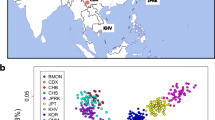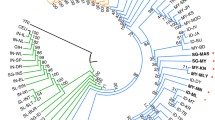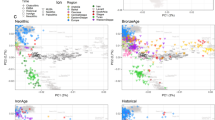Abstract
Indian populations are classified into various caste, tribe and religious groups, which altogether makes them very unique compared to rest of the world. The long-term firm socio-religious boundaries and the strict endogamy practices along with the evolutionary forces have further supplemented the existing high-level diversity. As a result, drawing definite conclusions on its overall origin, affinity, health and disease conditions become even more sophisticated than was thought earlier. In spite of these challenges, researchers have undertaken tireless and extensive investigations using various genetic markers to estimate genetic variation and its implication in health and diseases. We have demonstrated that the Indian populations are the descendents of the very first modern humans, who ventured the journey of out-of-Africa about 65,000 years ago. The recent gene flow from east and west Eurasia is also evident. Thus, this review attempts to summarize the unique genetic variation among Indian populations as evident from our extensive study among approximately 20,000 samples across India.


Similar content being viewed by others
References
Abbi A 2006 Endangered languages of the Andaman Islands (München Lincom Europa)
Agarwal SS, Phadke SR, Phadke RV, Das SK, Singh GK, Sharma JP, Teotia SP and Saxena BN 1994 Handigodu disease a radiological study. A new variety of spondyloepi(meta)physeal dysplasia of the autosomal dominant type. Skeletal Radiol. 23 611–619
Badadani M, Shetty KT, Babu SV and Agarwal SS 2008 Metabolic status of magnesium and ceruloplasmin in Handigodu Joint Disease a variety of spondylo epi (meta) physeal dysplasia. Clin. Chim. Acta 395 170–171
Bamshad M, Kivisild T, Watkins WS, Dixon ME, Ricker CE, Rao BB, Naidu JM, Prasad BV, Reddy PG, Rasanayagam A, et al. 2001 Genetic evidence on the origins of Indian caste populations. Genome Res. 11 994–1004
Bandelt HJ and Kivisild T 2006 Quality assessment of DNA sequence data autopsy of a mis-sequenced mtDNA population sample. Ann. Hum. Genet. 70 314–326
Barik SS, Sahani R, Prasad BV, Endicott P, Metspalu M, Sarkar BN, Bhattacharya S, Annapoorna PC, Sreenath J, Sun D, et al. 2008 Detailed mtDNA genotypes permit a reassessment of the settlement and population structure of the Andaman Islands. Am. J. Phys. Anthropol. 136 19–27
Barnabas S, Apte RV and Suresh CG 1996 Ancestry and interrelationships of the Indians and their relationship with other world populations a study based on mitochondrial DNA polymorphisms. Ann. Hum. Genet. 60 409–422
Basu A, Mukherjee N, Roy S, Sengupta S, Banerjee S, Chakraborty M, Dey B, Roy M, Roy B, Bhattacharyya NP, et al. 2003 Ethnic India a genomic view, with special reference to peopling and structure. Genome Res 13 2277–2290
Behar DM, Metspalu E, Kivisild T, Rosset S, Tzur S, Hadid Y, Yudkovsky G, Rosengarten D, Pereira L, Amorim A, et al. 2008 Counting the founders the matrilineal genetic ancestry of the Jewish Diaspora. PLoS One 3 e2062
Behar DM, Yunusbayev B, Metspalu M, Metspalu E, Rosset S, Parik J, Rootsi S, Chaubey G, Kutuev I, Yudkovsky G, et al. 2010 The genome-wide structure of the Jewish people. Nature 466 238–242
Callaway E 2012 Archaeology Date with history. Nature 485 27–29
Cavalli-Sforza LL 1998 The DNA revolution in population genetics. Trends Genet. 14 60–65
Cavalli-Sforza LL and Edwards AW 1967 Phylogenetic analysis. Models and estimation procedures. Am. J. Hum. Genet. 19 233–257
Chamyal LS, Maurya DM, Raj R, Juyal N, Bhandari S, Pant RK and Gaillard C 2011 Discovery of a Robust Fossil Homo sapiens in India (Orsang River Valley, Lower Narmada Basin, Gujarat). Possible Continuity with Asian Homo erectus. Acta Anthropologica Sinica 2 158–191
Chandrasekar A, Kumar S, Sreenath J, Sarkar BN, Urade BP, Mallick S, Bandopadhyay SS, Barua P, Barik SS, Basu D, et al. 2009 Updating phylogeny of mitochondrial DNA macrohaplogroup m in India dispersal of modern human in South Asian corridor. PLoS One 4 e7447
Chaubey G, Metspalu M, Kivisild T and Villems R 2007 Peopling of South Asia investigating the caste-tribe continuum in India. Bioessays 29 91–100
Chaubey G, Karmin M, Metspalu E, Metspalu M, Selvi-Rani D, Singh VK, Parik J, Solnik A, Naidu BP, Kumar A, et al. 2008 Phylogeography of mtDNA haplogroup R7 in the Indian peninsula. BMC Evol. Biol. 8 227
Chaubey G, Metspalu M, Choi Y, Magi R, Romero IG, Soares P, van Oven M, Behar DM, Rootsi S, Hudjashov G, et al. 2011 Population genetic structure in Indian Austroasiatic speakers the role of landscape barriers and sex-specific admixture. Mol. Biol. Evol. 28 1013–1024
Clarkson C, Petraglia M, Korisettar R, Haslam M, Boivin N, Crowther A, Ditchfield P, Fuller D, Miracle P, Harris C, et al. 2009 The oldest and longest enduring microlithic sequence in India 35 000 years of modern human occupation and change at the Jwalapuram Locality 9 rockshelter; in The oldest and longest enduring microlithic sequence in India 35 000 years of modern human occupation and change at the Jwalapuram Locality 9 rockshelter vol 83 pp 326–348
Dhandapany PS, Sadayappan S, Xue Y, Powell GT, Rani DS, Nallari P, Rai TS, Khullar M, Soares P, Bahl A, et al. 2009 A common MYBPC3 (cardiac myosin binding protein C) variant associated with cardiomyopathies in South Asia. Nat. Genet. 41 187–191
Diffloth G 2009 More on Dvaravati Old Mon. Fourth International Conference on Austroasiatic Linguistics, Mahidol University at Salaya, 29 October 2009
Dipierri JE, Alfaro E, Martinez-Marignac VL, Bailliet G, Bravi CM, Cejas S and Bianchi NO 1998 Paternal directional mating in two Amerindian subpopulations located at different altitudes in northwestern Argentina. Hum. Biol. 70 1001–1010
Eaaswarkhanth M, Dubey B, Meganathan PR, Ravesh Z, Khan FA, Singh L, Thangaraj K and Haque I 2009 Diverse genetic origin of Indian Muslims evidence from autosomal STR loci. J. Hum. Genet. 54 340–348
Eaaswarkhanth M, Haque I, Ravesh Z, Romero IG, Meganathan PR, Dubey B, Khan FA, Chaubey G, Kivisild T, Tyler-Smith C, et al. 2010 Traces of sub-Saharan and Middle Eastern lineages in Indian Muslim populations. Eur. J. Hum. Genet. 18 354–363
Fuller D 2007 Non-Human Genetics, Agricultural Origins and Historical Linguistics in South Asia. Vertebrate Paleobiol. Paleoanthropol. 393–443
Goncalves R, Freitas A, Branco M, Rosa A, Fernandes AT, Zhivotovsky LA, Underhill PA, Kivisild T and Brehm A 2005 Y-chromosome lineages from Portugal, Madeira and Acores record elements of Sephardim and Berber ancestry. Ann. Hum. Genet. 69 443–454
Hammer MF, Spurdle AB, Karafet T, Bonner MR, Wood ET, Novelletto A, Malaspina P, Mitchell RJ, Horai S, Jenkins T and Zegura SL 1997 The geographic distribution of human Y chromosome variation. Genetics 145 787–805
Higham CJ 2003 Languages and farming dispersals austroasiatic languages and rice cultivation (Cambridge: The McDonald Institute for Archaeological Research)
Hudjashov G, Kivisild T, Underhill PA, Endicott P, Sanchez JJ, Lin AA, Shen P, Oefner P, Renfrew C, Villems R and Forster P 2007 Revealing the prehistoric settlement of Australia by Y chromosome and mtDNA analysis. Proc. Natl. Acad. Sci. USA 104 8726–8730
Kennedy KA, Deraniyagala SU, Roertgen WJ, Chiment J and Disotell T 1987 Upper pleistocene fossil hominids from Sri Lanka. Am. J. Phys. Anthropol. 72 441–461
Kivisild T, Bamshad MJ, Kaldma K, Metspalu M, Metspalu E, Reidla M, Laos S, Parik J, Watkins WS, Dixon ME, et al. 1999 Deep common ancestry of indian and western-Eurasian mitochondrial DNA lineages. Curr. Biol. 9 1331–1334
Kivisild T, Rootsi S, Metspalu M, Mastana S, Kaldma K, Parik J, Metspalu E, Adojaan M, Tolk HV, Stepanov V, et al. 2003 The genetic heritage of the earliest settlers persists both in Indian tribal and caste populations. Am. J. Hum. Genet. 72 313–332
Kivisild T, Reidla M, Metspalu E, Rosa A, Brehm A, Pennarun E, Parik J, Geberhiwot T, Usanga E and Villems R 2004 Ethiopian mitochondrial DNA heritage tracking gene flow across and around the gate of tears. Am. J. Hum. Genet. 75 752–770
Kumar V, Langstieh BT, Madhavi KV, Naidu VM, Singh HP, Biswas S, Thangaraj K, Singh L and Reddy BM 2006 Global patterns in human mitochondrial DNA and Y-chromosome variation caused by spatial instability of the local cultural processes. PLoS Genet. 2 e53
Kumar V, Reddy AN, Babu JP, Rao TN, Langstieh BT, Thangaraj K, Reddy AG, Singh L and Reddy BM 2007 Y-chromosome evidence suggests a common paternal heritage of Austro-Asiatic populations. BMC Evol. Biol. 7 47
Macaulay V, Hill C, Achilli A, Rengo C, Clarke D, Meehan W, Blackburn J, Semino O, Scozzari R, Cruciani F, et al. 2005 Single, rapid coastal settlement of Asia revealed by analysis of complete mitochondrial genomes. Science 308 1034–1036
Mehrotra S, Oommen J, Mishra A, Sudharshan M, Tiwary P, Jamieson SE, Fakiola M, Rani DS, Thangaraj K, Rai M, et al. 2011 No evidence for association between SLC11A1 and visceral leishmaniasis in India. BMC Med. Genet. 12 71
Metspalu M, Kivisild T, Metspalu E, Parik J, Hudjashov G, Kaldma K, Serk P, Karmin M, Behar DM, Gilbert MT, et al. 2004 Most of the extant mtDNA boundaries in south and southwest Asia were likely shaped during the initial settlement of Eurasia by anatomically modern humans. BMC Genet. 5 26
Metspalu M, Romero IG, Yunusbayev B, Chaubey G, Mallick CB, Hudjashov G, Nelis M, Magi R, Metspalu E, Remm M, et al. 2011 Shared and unique components of human population structure and genome-wide signals of positive selection in South Asia. Am. J. Hum. Genet. 89 731–744
Misra VN 2001 Prehistoric human colonization of India. J. Biosci. 26 491–531
Mountain JL, Hebert JM, Bhattacharyya S, Underhill PA, Ottolenghi C, Gadgil M and Cavalli-Sforza LL 1995 Demographic history of India and mtDNA-sequence diversity. Am. J. Hum. Genet. 56 979–992
Nalini A, Yamini BK, Gayatri N, Thennarasu K and Gope R 2006 Familial Madras motor neuron disease (FMMND) study of 15 families from southern India. J. Neurol. Sci. 250 140–146
Nalini A, Thennarasu K, Yamini BK, Shivashankar D and Krishna N 2008 Madras motor neuron disease (MMND) clinical description and survival pattern of 116 patients from Southern India seen over 36 years (1971–2007). J. Neurol. Sci. 269 65–73
Narang A, Jha P, Rawat V, Mukhopadhyay A, Dash D, Basu A and Mukerji M 2011 Recent admixture in an Indian population of African ancestry. Am. J. Hum. Genet. 89 111–120
Nei M and Roychoudhury A 1982 Genetic relationship and evolution of human races. Evol. Biol. 14 1–59
Palanichamy MG, Agrawal S, Yao YG, Kong QP, Sun C, Khan F, Chaudhuri TK and Zhang YP 2006 Comment on "Reconstructing the origin of Andaman islanders". Science 311 470
Pandit JJ, Gopa S and Arora J 2011 A hypothesis to explain the high prevalence of pseudo-cholinesterase deficiency in specific population groups. Eur. J. Anaesthesiol. 28 550–552
Papiha SS 1996 Genetic variation in India. Hum. Biol. 68 607–628
Passarino G, Semino O, Pepe G, Shrestha SL, Modiano G and Santachiara Benerecetti AS 1992 MtDNA polymorphisms among Tharus of eastern Terai (Nepal). Gene Geogr. 6 139–147
Petraglia M, Korisettar R, Boivin N, Clarkson C, Ditchfield P, Jones S, Koshy J, Lahr MM, Oppenheimer C, Pyle D, et al. 2007 Middle Paleolithic assemblages from the Indian subcontinent before and after the Toba super-eruption. Science 317 114–116
Qamar R, Ayub Q, Khaliq S, Mansoor A, Karafet T, Mehdi SQ and Hammer MF 1999 African and Levantine origins of Pakistani YAP+ Y chromosomes. Hum. Biol. 71 745–755
Rani DS, Carlus SJ, Poongothai J, Jyothi A, Pavani K, Gupta NJ, Reddy AG, Rajan MM, Rao K, Chakravarty B, et al. 2009 CAG repeat variation in the mtDNA polymerase gamma is not associated with oligoasthenozoospermia. Int. J. Androl. 32 647–655
Rani DS, Dhandapany PS, Nallari P, Govindaraj P, Singh L and Thangaraj K 2010 Mitochondrial DNA haplogroup 'R' is associated with Noonan syndrome of south India. Mitochondrion 10 166–173
Rao PR and Gopalam KB 1979 High incidence of the silent allele at cholinesterase locus I in Vysyas of Andhra Pradesh (S. India). Hum. Genet. 52 139–141
Reich D, Thangaraj K, Patterson N, Price AL and Singh L 2009 Reconstructing Indian population history. Nature 461 489–494
Richards M, Macaulay V, Hickey E, Vega E, Sykes B, Guida V, Rengo C, Sellitto D, Cruciani F, Kivisild T, et al. 2000 Tracing European founder lineages in the Near Eastern mtDNA pool. Am. J. Hum. Genet. 67 1251–1276
Robb P 2002 A history of India (Houndmills)
Rootsi S, Magri C, Kivisild T, Benuzzi G, Help H, Bermisheva M, Kutuev I, Barac L, Pericic M, Balanovsky O, et al. 2004 Phylogeography of Y-chromosome haplogroup I reveals distinct domains of prehistoric gene flow in europe. Am. J. Hum. Genet. 75 128–137
Sahoo S, Singh A, Himabindu G, Banerjee J, Sitalaximi T, Gaikwad S, Trivedi R, Endicott P, Kivisild T, Metspalu M, et al. 2006 A prehistory of Indian Y chromosomes evaluating demic diffusion scenarios. Proc. Natl. Acad. Sci. USA 103 843–848
Schimmel A 1982 Islam in India and Pakistan (Leiden Brill)
Scholz CA, Johnson TC, Cohen AS, King JW, Peck JA, Overpeck JT, Talbot MR, Brown ET, Kalindekafe L, Amoako PY, et al. 2007 East African megadroughts between 135 and 75 thousand years ago and bearing on early-modern human origins. Proc. Natl. Acad. Sci. USA 104 16416–16421
Semino O, Torroni A, Scozzari R, Brega A and Santachiara Benerecetti AS 1991 Mitochondrial DNA polymorphisms among Hindus a comparison with the Tharus of Nepal. Ann. Hum. Genet. 55 123–136
Sengupta S, Zhivotovsky LA, King R, Mehdi SQ, Edmonds CA, Chow CE, Lin AA, Mitra M, Sil SK, Ramesh A, et al. 2006 Polarity and temporality of high-resolution y-chromosome distributions in India identify both indigenous and exogenous expansions and reveal minor genetic influence of Central Asian pastoralists. Am. J. Hum. Genet. 78 202–221
Shah AM, Tamang R, Moorjani P, Rani DS, Govindaraj P, Kulkarni G, Bhattacharya T, Mustak MS, Bhaskar LV, Reddy AG, et al. 2011 Indian Siddis African descendants with Indian admixture. Am. J. Hum. Genet. 89 154–161
Sharma G, Tamang R, Chaudhary R, Singh VK, Shah AM, Anugula S, Rani DS, Reddy AG, Eaaswarkhanth M, Chaubey G, et al. 2012 Genetic affinities of the central Indian tribal populations. PLoS One 7 e32546
Soodyall H and Jenkins T 1992 Mitochondrial DNA studies in the South African Indian population. Gene Geogr. 6 127–137
Stringer CB and Andrews P 1988 Genetic and fossil evidence for the origin of modern humans. Science 239 1263–1268
Thangaraj K, Ramana GV and Singh L 1999 Y-chromosome and mitochondrial DNA polymorphisms in Indian populations. Electrophoresis 20 1743–1747
Thangaraj K, Singh L, Reddy AG, Rao VR, Sehgal SC, Underhill PA, Pierson M, Frame IG and Hagelberg E 2003 Genetic affinities of the Andaman Islanders, a vanishing human population. Curr. Biol. 13 86–93
Thangaraj K, Chaubey G, Kivisild T, Reddy AG, Singh VK, Rasalkar AA and Singh L 2005 Reconstructing the origin of Andaman Islanders. Science 308 996
Thangaraj K, Chaubey G, Singh VK, Vanniarajan A, Thanseem I, Reddy AG and Singh L 2006a In situ origin of deep rooting lineages of mitochondrial Macrohaplogroup 'M' in India. BMC Genomics 7 151
Thangaraj K, Chaubey G, Reddy AG, Singh VK and Singh L 2006b Unique origin of Andaman Islanders insight from autosomal loci. J. Hum. Genet. 51 800–804
Thangaraj K, Nandan A, Sharma V, Sharma VK, Eaaswarkhanth M, Patra PK, Singh S, Rekha S, Dua M, Verma N, et al. 2009 Deep rooting in-situ expansion of mtDNA Haplogroup R8 in South Asia. PLoS One 4 e6545
Thangaraj K, Naidu BP, Crivellaro F, Tamang R, Upadhyay S, Sharma VK, Reddy AG, Walimbe SR, Chaubey G, Kivisild T and Singh L 2010 The influence of natural barriers in shaping the genetic structure of Maharashtra populations. PLoS One 5 e15283
Underhill PA and Kivisild T 2007 Use of y chromosome and mitochondrial DNA population structure in tracing human migrations. Annu. Rev. Genet. 41 539–564
Underhill PA, Myres NM, Rootsi S, Metspalu M, Zhivotovsky LA, King RJ, Lin AA, Chow CE, Semino O, Battaglia V, et al. 2010 Separating the post-Glacial coancestry of European and Asian Y chromosomes within haplogroup R1a. Eur. J. Hum. Genet. 18 479–484
van Driem G 2001. Languages of the Himalayas: An ethnolinguistic handbook of the greater Himalayan region with an introduction to the symbiotic theory of language (2 vols.). Leiden: Brill
Watkins WS, Bamshad M, Dixon ME, Bhaskara Rao B, Naidu JM, Reddy PG, Prasad BV, Das PK, Reddy PC, Gai PB, et al. 1999 Multiple origins of the mtDNA 9-bp deletion in populations of South India. Am. J. Phys. Anthropol. 109 147–158
Xing J, Watkins WS, Witherspoon DJ, Zhang Y, Guthery SL, Thara R, Mowry BJ, Bulayeva K, Weiss RB and Jorde LB 2009 Fine-scaled human genetic structure revealed by SNP microarrays. Genome Res. 19 815–825
Yotova V, Lefebvre JF, Kohany O, Jurka J, Michalski R, Modiano D, Utermann G, Williams SM and Labuda D 2007Tracing genetic history of modern humans using X-chromosome lineages. Hum. Genet. 22 431–443
Zhivotovsky LA, Underhill PA, Cinnioglu C, Kayser M, Morar B, Kivisild T, Scozzari R, Cruciani F, Destro-Bisol G, Spedini G, et al. 2004 The effective mutation rate at Y chromosome short tandem repeats, with application to human population-divergence time. Am. J. Hum. Genet. 74 50–61
Acknowledgements
We thank all our national and international collaborators for their constant cooperation and efficient teamwork. We also thank the students of various universities across the country for their valuable contributions in sampling. LS and KT are supported by the Council of Scientific and Industrial Research (CSIR), India. Financial supports to LS and KT from Department of Biotechnology (DBT), India, and Department of Science and Technology (DST), India, are gratefully acknowledged. LS is also supported by Bhatnagar Fellowship (CSIR) and Bose Fellowship (DST).
Author information
Authors and Affiliations
Corresponding author
Additional information
[Tamang R, Singh L and Thangaraj K 2012 Complex genetic origin of Indian populations and its implications. J. Biosci. 37 1–9] DOI 10.1007/s12038-012-9256-9
Rights and permissions
About this article
Cite this article
Tamang, R., Singh, L. & Thangaraj, K. Complex genetic origin of Indian populations and its implications. J Biosci 37, 911–919 (2012). https://doi.org/10.1007/s12038-012-9256-9
Published:
Issue Date:
DOI: https://doi.org/10.1007/s12038-012-9256-9




